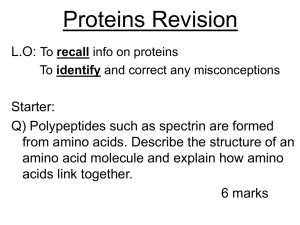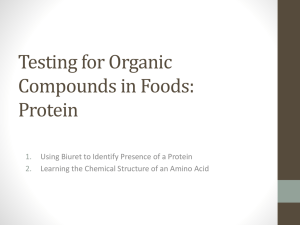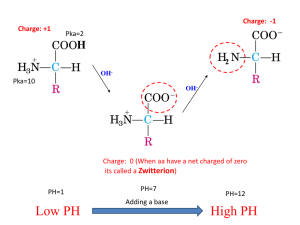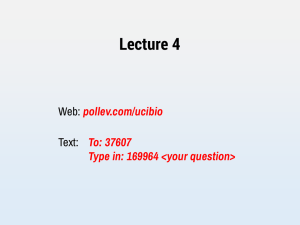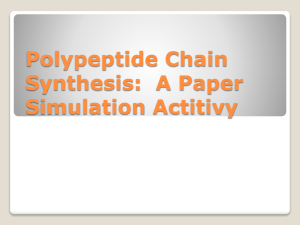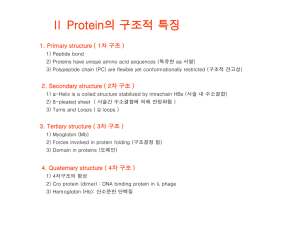Organic Chemistry
advertisement
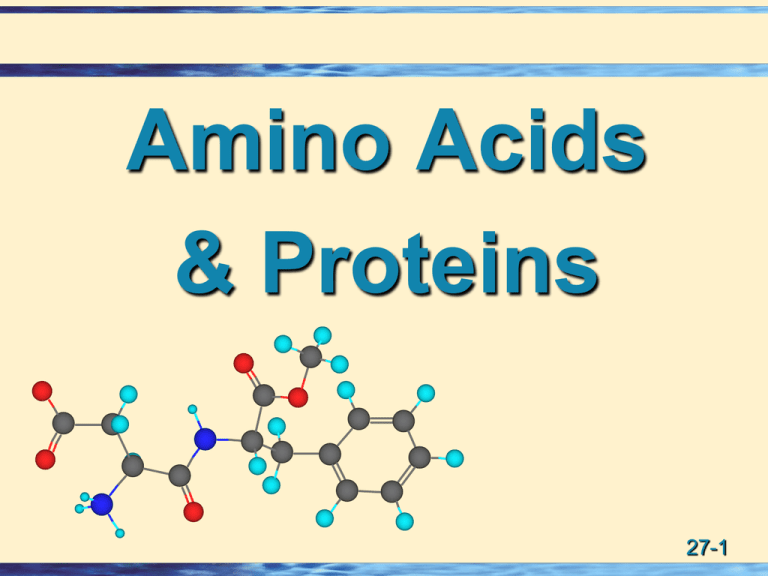
Amino Acids & Proteins 27-1 Amino Acids Amino acid: A compound that contains both an amino group and a carboxyl group. • -Amino acid: An amino acid in which the amino group is on the carbon adjacent to the carboxyl group. • although -amino acids are commonly written in the unionized form, they are more properly written in the zwitterion (internal salt) form. O RCHCOH NH2 -Ami no Acid O RCHCO NH3 + Zwi tteri on form 27-2 Chirality of Amino Acids With the exception of glycine, all protein-derived amino acids have at least one stereocenter (the -carbon) and are chiral. • the vast majority have the L-configuration at their carbon. COOH N H3 + CH3 D-Alan i ne COOH 3N H CH3 L-A lan in e 27-3 Amino Acids with Nonpolar side chains COO- Al an i n e (Ala, A) N H3 + COO- Ph e n yl alan i ne (Ph e , F) + N H3 COO- Gl yci ne (Gly, G) N H3 + COO- Is ol e u ci n e (Il e, I) N H3 + - COO N H3 + S Le u ci n e (Le u , L) COO- Me th i on in e (Me t, M) + N H3 - Prol i ne COO N (Pro, P) H H N H COO- Tryptoph an (Trp, W) N H3 + COO- Vali n e (Val , V) N H3 + 27-4 With Polar side chains COO- H2N O N H3 + As paragi n e (Asn , N) O H 2N COON H3 + Gl utami n e (Gln , Q ) HO COO- Se ri n e (Se r, S ) N H3 + OH COO- Th reon i n e (Th r, T) NH + 3 27-5 With Acidic & Basic Side Chains - COO- O O N H3 As partic acid (Asp, D) H 2N + N H2 + O - COO-Gl utami c aci d N H + (Glu , E) O N H 3 N 3 - HS COO N H3 + - COO HO N H3 + N H Cyste in e (C ys, C ) Tyros in e (Tyr, Y) + H 3N COO- Argi n in e (Arg, R) NH + COON H3 + COON H3 + Hi stidi n e (His , H) Lysi n e (Lys , K) 27-6 Acid-Base properties, Non polar and polar side chains N onpolar & polar side ch ains alanin e asp aragine glutamine glycine isoleucine leucine methionine ph enylalanine proline serine threonine tryp top han valine pK a of pK a of COOH 2.35 2.02 2.17 2.35 2.32 2.33 2.28 2.58 2.00 2.21 2.09 2.38 2.29 NH3 9.87 8.80 9.13 9.78 9.76 9.74 9.21 9.24 10.60 9.15 9.10 9.39 9.72 + 27-8 Acid-Base Properties, Acidic/Basic Side Chains Acid ic Side Ch ains aspartic acid glu tamic acid cysteine tyros ine pK a of Basic Side Ch ains arginin e histid ine lys ine pK a of pK a of COOH NH3 2.10 9.82 2.10 9.47 2.05 10.25 2.20 9.11 pK a of COOH NH3 2.01 9.04 1.77 9.18 2.18 8.95 + + pK a of Side Ch ain 3.86 4.07 8.00 10.07 Sid e Chain Grou p carboxyl carboxyl su fh yd ryl ph enolic pK a of Side Ch ain 12.48 6.10 10.53 Sid e Chain Grou p guanid ino imidazole 1° amin o 27-9 Acidity: -COOH Groups average pKa of an -carboxyl group is 2.19, which makes them considerably stronger acids than acetic acid (pKa 4.76). The • The greater acidity is accounted for by the electronwithdrawing inductive effect of the adjacent -NH3+ group. RCHCOOH NH3 + + H2 O RCHCOONH3 + + H3 O pK a = 2.19 + Note that the NH2 will be protonated at these low pHs 27-10 Acidity: side chain -COOH Due to the electron-withdrawing inductive effect of the -NH3+ group, side chain -COOH groups are also stronger than acetic acid. • The effect decreases with distance from the -NH3+ group. Compare: -COOH group of alanine (pKa 2.35) -COOH group of aspartic acid (pKa 3.86) -COOH group of glutamic acid (pKa 4.07) 27-11 Acidity: -NH3+ groups average value of pKa for an -NH3+ group is 9.47, compared with a value of 10.76 for a 1° alkylammonium ion. The RCHCOO + H2 O + NH3 CH3 CHCH3 + H2 O + NH3 - + RCHCOO + H3 O NH2 pK a = 9.47 + CH3 CHCH3 + H3 O NH2 pK a = 10.60 27-12 Details: The Guanidine Group of Arg • The basicity of the guanidine group is attributed to the large resonance stabilization of the protonated form relative to the neutral form. NH2 + : : NH2 + RNH C : : NH2 RNH C RNH C + NH2 NH2 : : NH2 H2 O : NH2 + + H3 O RN C pK a = 12.48 : NH2 27-13 Details: Imidazole Group • The imidazole group is a heterocyclic aromatic amine. H •• N N+ H H NH3 + + N - COO NH3 + •• N H2 O COO- + H3 O H N ot a p art of th e aromatic sextet; the proton accep tor •• N •• N H NH3 + + H O + 3 COO - pKa 6.10 27-14 Useful Recall from buffer solutions Ka = [H+] [A-] [HA] / If Ka = [H+] then [A-] = [HA] 27-15 Isoelectric Point Isoelectric point (pI): pH at which an amino acid, polypeptide, or protein has a total charge of zero. • The pI for glycine, for example, falls between the pKa values for the carboxyl and amino groups. 1 pI = 2 + ( pKa COOH + pKa NH 3 ) = 1 (2.35 + 9.78) = 6.06 2 27-16 Isoelectric Point of glycine continued Again 1 pI = 2 + ( pKa COOH + pKa NH 3 ) = 1 (2.35 + 9.78) = 6.06 2 pKa = pH-log([conj base]/[acid]) At pH = 6.06 For carboxyl group 2.35 = 6.06 - log ([RCO2-]/[RCO2H]) 6.06- 2.35 = 3.71 = log ([RCO2-]/[RCO2H]) ([RCO2-]/[RCO2H]) = 103.71 or 99.98% ionized as neg ion. For amino group 9.78 = 6.06 - log([RNH2]/[RNH3+]) ([RNH2]/[RNH3+]) = 10-3.72 or 99.98% protonated. On average Zero Chg. 27-17 Furthermore….. A+ B C- [A+] = [C-] 27-18 Titration of conjugate acid of glycine with NaOH. Strongly acid -CO2H and -NH3+ Buffer solution. [-CO2H] = [-CO2-] Isoelectric. Zero net charge. Buffer solution. [-NH3+]=[-NH2] Strongly basic -CO2- and NH2 27-19 Isoelectric Point N onpolar & pK a of pK a of polar side + COOH NH ch ains 3 alanin e 2.35 9.87 asp aragine 2.02 8.80 glutamine 2.17 9.13 glycine 2.35 9.78 isoleucine 2.32 9.76 leucine 2.33 9.74 methionine 2.28 9.21 ph enylalanine 2.58 9.24 proline 2.00 10.60 serine 2.21 9.15 threonine 2.09 9.10 tryp top han 2.38 9.39 valine 2.29 9.72 pK a of Sid e Chain ---------------------------------------- pI 6.11 5.41 5.65 6.06 6.04 6.04 5.74 5.91 6.30 5.68 5.60 5.88 6.00 If pH is lower than pI then more protonated molecules. If higher then more negative charge. 27-20 Isoelectric Point Acidic Sid e Ch ains asp artic acid glutamic acid cystein e tyrosin e Basic Sid e Ch ains argin ine his tidine lysine pK a of + Sid e COOH NH3 Chain 2.10 9.82 3.86 2.10 9.47 4.07 2.05 10.25 8.00 2.20 9.11 10.07 pK a of pK a of pK a of + Sid e COOH NH3 Chain 2.01 9.04 12.48 1.77 9.18 6.10 2.18 8.95 10.53 pK a of pI 2.98 3.08 5.02 5.63 pK a of pI 10.76 7.64 9.74 Three buffered pHs 27-21 Aspartic acid B A+ pKa 2.10 pH = pKa [A+] = [B] C- 3.86 [B] = [C-] pI = (2.10 + 3.86)/2 [A+] = [C-] [D2-] approx 0 D2- 9.82 Note species B has zero net charge. pKa1 and pKa2 control [A+] and [C-] which should be equal. 27-22 Arginine A2+ B+ C D- pI = (9.04+12.48)/2 =10.76 [B+] = [D-]; [A2+] about 0 27-23 Electrophoresis Electrophoresis: The process of separating compounds on the basis of their electric charge. • electrophoresis of amino acids can be carried out using paper, starch, polyacrylamide and agarose gels, and cellulose acetate as solid supports. 27-24 Electrophoresis • A sample of amino acids is applied as a spot on the paper strip. • An electric potential is applied to the electrode vessels and amino acids migrate toward the electrode with charge opposite their own. • Molecules with a high charge density move faster than those with low charge density. • Molecules at isoelectric point remain at the origin. • After separation is complete, the strip is dried and developed to make the separated amino acids visible. • After derivitization with ninhydrin, 19 of the 20 amino acids give the same purple-colored anion; proline gives an orange-colored compound. 27-25 Electrophoresis • The reagent commonly used to detect amino acid is ninhydrin. O RCHCO + 2 + NH3 An -amino acid O OH OH O N inh yd rin - O O N O + RCH + CO2 + H3 O+ O O Pu rp le-colored anion 27-26 Polypeptides & Proteins In 1902, Emil Fischer proposed that proteins are long chains of amino acids joined by amide bonds to which he gave the name peptide bonds. Peptide bond: The special name given to the amide bond between the -carboxyl group of one amino acid and the -amino group of another. 27-27 Serinylalanine (Ser-Ala) HOCH2 H H 2N O O O S e ri n e (Se r, S ) H + H 2N O H H CH3 Al an i n e (Ala, A) pe ptide bon d HOCH2 H H O N H H 2N O O H CH 3 S e ri n ylalan i n e (Se r-Al a, (S -A) 27-28 Peptides • Peptide: The name given to a short polymer of amino acids joined by peptide bonds; they are classified by the number of amino acids in the chain. • Dipeptide: A molecule containing two amino acids joined by a peptide bond. • Tripeptide: A molecule containing three amino acids joined by peptide bonds. • Polypeptide: A macromolecule containing many amino acids joined by peptide bonds. • Protein: A biological macromolecule of molecular weight 5000 g/mol or greater, consisting of one or more polypeptide chains. 27-29 Writing Peptides • By convention, peptides are written from the left, beginning with the free -NH3+ group and ending with the free -COO- group on the right. + H 3N N-te rminal ami no aci d O C6 H5 O H N C-te rmi nal ami no aci d N OH O OH COOSe r-Phe -As n 27-30 Writing Peptides • The tetrapeptide Cys-Arg-Met-As At pH 8 it would be • At pH 6.0, its net charge is +1. half ionized. p Ka 8.00 N-termin al amin o acid + H3 N SH H N SCH3 O H N N H O O NH H2 N NH2 + C-terminal amino acid O - O NH2 O pK a 12.48 27-31 Primary Structure Primary structure: The sequence of amino acids in a polypeptide chain; read from the N-terminal amino acid to the C-terminal amino acid: Amino acid analysis: • Hydrolysis of the polypeptide, most commonly carried out using 6M HCl at elevated temperature. • Quantitative analysis of the hydrolysate by ionexchange chromatography. 27-32 Ion Exchange Chromatography Analysis of a mixture of amino acids by ion exchange chromatography 27-33 Cyanogen Bromide, BrCN • BrCN Selectively cleaves of peptide bonds formed by the carboxyl group of methionine. cyan ogen b romide is specific for the cleavage of this p eptide bond from the N-termin al end O O P N -C-NH CH C NH-PC CH2 CH2 -S-CH3 from the C-termin al end 27-34 Cyanogen Bromide, BrCN O HN pe pt id e COOH 3 N pe pt id e C-N H O + Br C N H2 O s ide ch ain of me th i on in e S- CH 3 O H 3 N pe pt id e C-N H 0.1 M HC l O O A s u bs ti tu ted-lacton e of the am in o acid h om os e rin e H 3 N pe pt id e COO- CH 3 S- C N Me th yl thi ocyan ate Mechanism to follow 27-35 Cyanogen Bromide, BrCN • Step 1: Nucleophilic displacement of bromine. H3 N O HN C-NH - O COO O H3 N - HN COO C-NH O Br : :S-CH3 Br C N Cyanogen bromide a sulfon ium ion; a good leaving group :S-CH3 C N 27-36 Cyanogen Bromide, BrCN • Step 2: Internal nucleophilic displacement of methyl thiocyanate. H3N C-NH : O COO- HN O O : S-CH3 C N H3N C-NH HN COO- : An i mi n olacton e h ydrobrom ide + CH3-S-C N : O Me th yl thi ocyan ate 27-37 Cyanogen Bromide, BrCN • Step 3: Hydrolysis of the imino group. O H3 N C-N H HN COOH2 O O O H3 N C-N H O O H 3N COO- A s u bs ti tu ted -lacton e of the am in o acid h om ose rin e 27-38 Enzyme Catalysis A group of protein-cleaving enzymes called proteases can be used to catalyze the hydrolysis of specific peptide bonds. Enzyme Catalyzes Hydrolysis of Pep tide Bond Formed b y Carboxyl Group of Tryps in Argin ine, lysine Chymotrypsin Phenylalanine, tyrosin e, tryptoph an 27-39 Edman Degradation Edman degradation: Cleaves the N-terminal amino acid of a polypeptide chain. N-terminal amino acid R + H3 N NH O - COO + S=C=N-Ph Phenyl isothiocyan ate R HN S O + H2 N COO- N Ph A p henylthiohydantoin 27-40 Edman Degradation • Step 1: Nucleophilic addition to the C=N group of phenylisothiocyanate and proton tautomerization R NH : H2 N O R O HN : : Ph N C S - COO Ph N H S NH COO- A d erivative of N-phen ylth iourea 27-41 Edman Degradation • Step 2: Nucleophilic addition of sulfur to the C=O of the adjacent amide group and acid catalysis. R HN Ph N H+ O R O–H HN NH COOH S + Ph-N H H S NH COOH H + H+ R HN O Ph-N + + H3 N COOH S A thiazolinone 27-42 Edman Degradation • Step 3: Isomerization of the thiazolinone ring. R HN Ph-N R O S + H-Nu substitution O HN Ph N SH keto-en ol tautomerism Nu A th iazolin on e R R O HN S NH Ph Nu - H-Nu HN O N Ph A p henylthiohydantoin S 27-43 DNFB tagging of N terminal AA 27-44 Carboxypeptidase cleavage of C terminal AA Treatment of peptide with carboxypeptidase cleaves the peptide linkage adjacent to the free alpha carboxyl group. It may then be identified. 27-45 Primary Structure, example Deduce the 1° structure of this pentapeptide Expe rim e n tal Proce du re Ami n o Acid C omposi ti on pe n tape ptide Arg, G lu , Hi s, Ph e , S er Edman De gradation Gl u GluHydrol ysi s - C h ymotryps in Fragme n t A Gl u , His , Ph e Glu-His-Phe Fragme n t B Arg, S e r Hydrol ysi s - Tryps in Fragme n t C Arg, G lu , Hi s, Ph e Glu-His-Phe-Arg-Ser Fragme n t D Ser using Enzyme Catalyzes Hydrolysis of Pep tide Bond Formed b y Carboxyl Group of Tryps in Argin ine, lysine Chymotrypsin Phenylalanine, tyrosin e, tryptoph an 27-46 Polypeptide Synthesis The problem in protein synthesis is how to join the -carboxyl group of aa-1 by an amide bond to the -amino group of aa-2, and not vice versa. O + O + H3 NCHCO + H3 NCHCO aa2 aa1 ? O + O H3 NCHCNHCHCO + H2 O aa1 aa2 27-47 Polypeptide Synthesis Strategy • Protect the -amino group of aa-1. • Activate the -carboxyl group of aa-1. • Protect the -carboxyl group of aa-2. prote ctin g grou p acti vatin g grou p prote ctin g grou p O O Z-N HCHC- Y + H2 N CH C-X a a2 a a1 form peptide bon d O O Z-N HCHCN HCHC-X + H- Y a a1 a a2 27-48 Amino-Protection • convert them to amides. O PhCH2 OCCl Benzyloxycarb on yl ch loride O O ( CH3 ) 3 COCOCOC(CH3 ) 3 D i-t ert-b utyl dicarbonate O PhCH2 OCBenzyloxycarb on yl (Z-) group O (CH3 ) 3 COCt ert -Bu toxycarbonyl (BOC-) grou p 27-49 Amino-Protection • Treatment of an amino group with either of these reagents gives a carbamate (an ester of the monoamide of carbonic acid). O O O 1. NaOH + PhCH2 OCNHCHCOH + H3 NCHCO 2. HCl, H O 2 CH3 CH3 Benzyloxycarbonyl Alanine N-Benzyloxycarbonylalanine chloride (Z-Cl) (Z-Ala) O PhCH2 OCCl • A carbamate is stable to dilute base but can be removed by treatment with HBr in acetic acid. O PhCH2 OCNH-peptide A Z-pro tected peptid e HBr CH3 COOH + PhCH2 Br + CO2 + H3 N-peptide Benzyl bromide Unprotected peptide 27-50 Amino-Protecting Groups The benzyloxycarbonyl group is also removed by hydrogenolysis. • The intermediate carbamic acid loses carbon dioxide to give the unprotected amino group. O PhCH2 OCNH-peptide + H2 A Z-pro tected peptid e Pd PhCH3 + CO2 + H2 N-pept ide Toluene Unprotected peptide 27-51 Carboxyl-Protecting Groups. Esters Carboxyl groups are most often protected as methyl, ethyl, or benzyl esters. • Methyl and ethyl esters are prepared by Fischer esterification, and removed by hydrolysis in aqueous base under mild conditions. • Benzyl esters are removed by hydrogenolysis; they are also removed by treatment with HBr in acetic acid 27-52 Peptide Bond Formation The reagent most commonly used to bring about peptide bond formation is DCC. • DCC is the anhydride of a disubstituted urea and, when treated with water, is converted to DCU. N C N + H2 O 1,3-D icy clo hexyl carbod ii mide (D CC) O N C N In bringing about formation of a peptide bond, DCC acts a dehydrating agent. H H N,N' -d icy clo hexy lu rea (D CU) 27-53 Peptide Bond Formation O O CHCl 3 Z-N HCHC- OH + H2 NCHCOCH3 + DCC R1 R2 Ami n o-prote cte d C arboxyl-protected aa1 aa2 O O Z-N HCHC- NHCH COCH3 + DCU R1 R2 Ami n o an d carboxyl prote cte d dipe pti de 27-54 Solid-Phase Synthesis Bruce Merrifield, 1984 Nobel Prize for Chemistry • Solid support: a type of polystyrene in which about 5% of the phenyl groups carry a -CH2Cl group. • The amino-protected C-terminal amino acid is bonded as a benzyl ester to the support beads. • The polypeptide chain is then extended one amino acid at a time from the N-terminal end. • When synthesis is completed, the polypeptide is released from the support beads by cleavage of the benzyl ester. 27-55 Solid-Phase Synthesis The solid support used in the Merrifield solid phase synthesis. 27-56 27-57 Solid-Phase Synthesis • Merrifield synthesized the enzyme ribonuclease, a protein containing 124 amino acids 27-58 Peptide Bond Geometry • The four atoms of a peptide bond and the two alpha carbons joined to it lie in a plane with bond angles of 120° about C and N. • Model of the zwitterion form of Gly-Gly viewed from two perspectives to show the planarity of the six atoms of the peptide bond and the preferred s-trans geometry. 27-59 Peptide Bond Geometry • To account for this geometry, Linus Pauling proposed that a peptide bond is most accurately represented as a hybrid of two contributing structures. • The hybrid has considerable C-N double bond character and rotation about the peptide bond is restricted. : : - :O C : C C :O : C N H C + C N H 27-60 Peptide Bond Geometry • Two conformations are possible for a planar peptide bond. • Virtually all peptide bonds in naturally occurring proteins studied to date have the s-trans conformation. • • C O •• H • • •• O •• C C •• N C H s-t rans N C C s-cis 27-61 Secondary Structure Secondary structure: The ordered arrangements (conformations) of amino acids in localized regions of a polypeptide or protein. To determine from model building which conformations would be of greatest stability, Pauling and Corey assumed that: 1. All six atoms of each peptide bond lie in the same plane and in the s-trans conformation. 2. There is hydrogen bonding between the N-H group of one peptide bond and a C=O group of another peptide bond as shown in the next screen. 27-62 Secondary Structure • Hydrogen bonding between amide groups. 27-63 Secondary Structure On the basis of model building, Pauling and Corey proposed that two types of secondary structure should be particularly stable: • -Helix. • Antiparallel -pleated sheet. -Helix: A type of secondary structure in which a section of polypeptide chain coils into a spiral, most commonly a right-handed spiral. 27-64 The -Helix • The polypeptide chain is repeating units of L-alanine. H bonds (C=O…H) parallel to axis of helix 27-65 The -Helix In a section of -helix: • There are 3.6 amino acids per turn of the helix. • Each peptide bond is s-trans and planar. • N-H groups of all peptide bonds point in the same direction, which is roughly parallel to the axis of the helix. • C=O groups of all peptide bonds point in the opposite direction, and also parallel to the axis of the helix. • The C=O group of each peptide bond is hydrogen bonded to the N-H group of the peptide bond four amino acid units away from it. • All R- groups point outward from the helix. 27-66 The -Helix -helix of repeating units of L-alanine An • A ball-and-stick model viewed looking down the axis of the helix. • A space-filling model viewed from the side. 27-67 -Pleated Sheet antiparallel -pleated sheet consists of adjacent polypeptide chains running in opposite directions: The • Each peptide bond is planar and has the s-trans conformation. • The C=O and N-H groups of peptide bonds from adjacent chains point toward each other and are in the same plane so that hydrogen bonding is possible between them. • All R- groups on any one chain alternate, first above, then below the plane of the sheet, etc. 27-68 -Pleated Sheet • -pleated sheet with three polypeptide chains running in opposite directions (antiparallel). 27-69 Tertiary Structure Tertiary structure: The three-dimensional arrangement in space of all atoms in a single polypeptide chain. • Disulfide bonds between the side chains of cysteine play an important role in maintaining 3° structure. 27-70 Tertiary Structure • A ribbon model of myoglobin. 27-71 Quaternary Structure Quaternary structure: The arrangement of polypeptide chains into a noncovalently bonded aggregation. • The major factor stabilizing quaternary structure is the hydrophobic effect. Hydrophobic effect: The tendency of nonpolar groups to cluster together in such a way as to be shielded from contact with an aqueous environment. 27-72 Quaternary Structure • The quaternary structure of hemoglobin. The -chains in yellow, the heme ligands in red, and the Fe atoms as white spheres. 27-73 Quaternary Structure • If two polypeptide chains, for example, each have one hydrophobic patch, each patch can be shielded from contact with water if the chains form a dimer. Pro tein N umber o f Subun its Al coho l dehyd rog enase 2 Al dol ase 4 Hemog lo bin 4 Lactate d eh ydrog enase 4 Insul in 6 Glu tamine sy nthetase 12 Tobacco mosai c vi rus 17 protei n d isc 27-74

